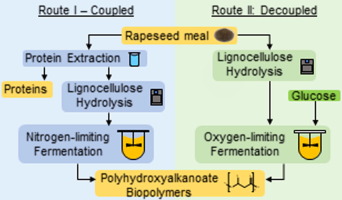Waste Management ( IF 7.1 ) Pub Date : 2020-03-03 , DOI: 10.1016/j.wasman.2020.02.033 Phavit Wongsirichot , Maria Gonzalez-Miquel , James Winterburn

|
Rapeseed meal (RSM) is a candidate for biopolymer production due to its abundance, low cost and potential integration with other rapeseed-derived products. However, existing studies pursuing such schemes are limited. The feasibility of different strategies for RSM valorization via protein extraction and polyhydroxyalkanoate production were evaluated. Nitrogen-limited RSM media was produced from hydrolysis of residues which had undergone extensive protein extraction using sodium hydroxide. A study of oxygen-limited fermentation was also performed on hydrolysate of untreated RSM via batch feeding. The typical strategy of using a high carbon-to-nitrogen ratio may not be the most suitable route for polyhydroxyalkanoate (PHA) production using nitrogen-rich biomass as a feedstock. Central composite design-based experiments show that due to mass transfer limitations protein extraction at 1-L scale could only achieve yields around 50% and 69%, at room temperature and 60 °C, respectively. Protein extraction yields reduced with successive extractions, meaning that whilst the RSM hydrolysate is viable for growth, designing a valorization scheme which has the fermentation step dictated by the protein extraction may not be practical/economical. A better route which utilizes oxygen-limitation to initially induce stationary phase was identified, giving accumulation of polyhydroxyalkanoate once the oxygen levels began to recover; 8.93% and 1.75% PHA accumulation in fed-batch cultures of synthetic and RSM media, respectively. The findings demonstrate that decoupling of protein extraction performance from PHA synthesis is feasible. This study provides important insight into the degrees of freedom available in the design of a holistic valorization scheme of rapeseed meal, and high protein lignocellulosic biomass in general.
中文翻译:

通过恶臭假单胞菌的氮和氧限制生产多羟基链烷酸酯的菜籽粕增值策略
油菜籽粉(RSM)由于其丰富,低成本以及与其他油菜籽衍生产品的潜在整合而成为生物聚合物生产的候选者。但是,进行这种方案的现有研究是有限的。评估了通过蛋白质提取和生产多羟基链烷酸酯进行RSM增值的不同策略的可行性。氮受限的RSM培养基是由残留物的水解产生的,这些残留物已使用氢氧化钠进行了广泛的蛋白质提取。还通过分批进料对未经处理的RSM的水解产物进行了限氧发酵的研究。使用高碳氮比的典型策略可能不是使用富氮生物质作为原料生产聚羟基链烷酸酯(PHA)的最合适途径。基于中央复合设计的实验表明,由于传质限制,在1 L规模的蛋白质提取只能分别在室温和60°C下获得约50%和69%的产率。连续提取会降低蛋白质的提取产量,这意味着尽管RSM水解产物可用于生长,但设计具有由蛋白质提取所决定的发酵步骤的增值方案可能并不实际/经济。确定了一个更好的途径,该途径利用氧限制来初始诱导固定相,一旦氧水平开始恢复,聚羟基链烷酸酯就会积累;在合成和RSM培养基的分批补料培养中,分别有8.93%和1.75%的PHA积累。这些发现表明,从PHA合成中分离蛋白质提取性能是可行的。











































 京公网安备 11010802027423号
京公网安备 11010802027423号